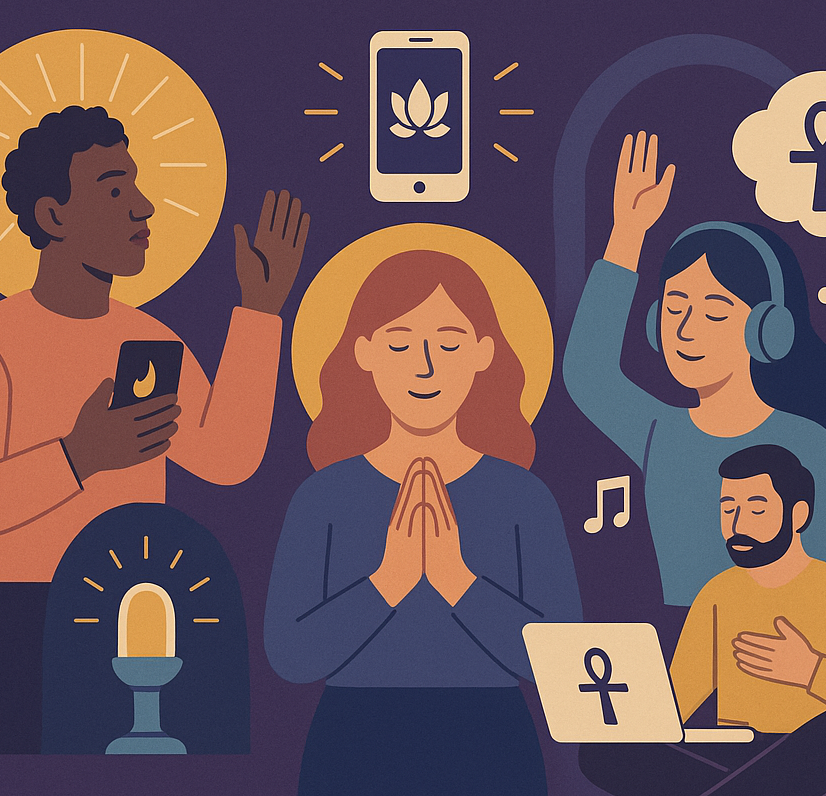Ritual Innovation: New Forms of Worship, New Meanings
Rituals have always been the heartbeat of religion—symbolic acts that connect the human with the divine, the individual with the community. For centuries, these practices were passed down unchanged, forming the rhythm of collective faith. Yet, in the 21st century, something remarkable is happening: rituals are evolving. From online prayer gatherings and eco-friendly festivals to personalized home altars and meditation apps, worship today is being reinvented in ways that reflect modern life. This wave of ritual innovation is not about abandoning tradition—it’s about finding new meanings in old forms.
The Changing Face of Worship
The Covid-19 pandemic was a turning point for religious practice. As temples, churches, and mosques closed their doors, believers turned to technology. Livestreamed aartis, virtual iftars, Zoom pujas, and online Bible studies became the new norm. What began as necessity has now evolved into a parallel spiritual culture. Even after the return of physical gatherings, digital rituals continue to thrive, offering accessibility to those separated by distance or disability.
In India, millions tune into morning prayers from the Kashi Vishwanath Temple or the Tirupati Balaji shrine via YouTube. During Ramadan, global online Quran recitations unite Muslims across continents. Virtual platforms have made worship participatory and borderless, turning the idea of “community” into something both local and global.
Personalization of the Sacred
Today’s spiritual seekers are not content with one-size-fits-all practices. Many are crafting personalized rituals—ways of connecting with the divine that align with their lifestyle, values, and identity. Some blend elements of multiple traditions, while others focus on mindfulness, gratitude, or nature-based spirituality.
In urban India, young professionals may light a diya before a laptop, chant mantras during a morning jog, or meditate using smartphone apps. For them, ritual is not about conformity—it’s about meaning. Across religions, this trend reflects a shift from institutional religion to individual spirituality. Faith becomes experiential, shaped by personal understanding rather than external authority.
Even traditional ceremonies are adapting. Weddings, funerals, and naming rituals are increasingly inclusive—featuring eco-conscious themes, interfaith blessings, and gender-neutral prayers. In these spaces, ritual innovation is about authenticity, not rebellion.
Eco-Spiritual Rituals: Worship Meets Sustainability
As environmental consciousness grows, faith communities are reimagining rituals through the lens of ecology. Temples are reducing plastic use in offerings, replacing synthetic garlands with natural flowers, and promoting “green” immersion practices for idols. Churches and gurdwaras are installing solar panels, while mosques are hosting clean-water initiatives inspired by the Quranic ethic of stewardship (khalifa).
New festivals like “Tree Raksha Bandhan,” where devotees tie threads around trees, or community drives to clean sacred rivers, blend devotion with ecological responsibility. These rituals speak to a deeper truth: that spirituality and sustainability are two sides of the same sacred duty. By linking worship with environmental action, communities are redefining holiness as care for creation.
Women and Youth as Innovators of Ritual
Women and young people are often at the forefront of ritual transformation. Across India, women priests are performing havans, marriages, and last rites—challenging centuries of exclusion while infusing rituals with new sensitivity. Their approach tends to emphasize inclusivity and compassion, balancing tradition with social progress.
Meanwhile, youth-led prayer groups, interfaith music festivals, and digital satsangs are reshaping how the next generation experiences faith. On social media, devotional content—bhajans, gospel songs, sufi poetry—circulates freely, transcending boundaries. For many young believers, spirituality is less about hierarchy and more about participation. They are blending art, activism, and devotion to create rituals that feel relevant in a changing world.
Hybrid Spaces: From Temples to Tech Platforms
Physical and digital spaces of worship are merging. Temples are launching apps for online darshan and donation management; churches are experimenting with virtual choirs; Buddhist monks conduct guided meditations on global platforms. The metaverse is even hosting virtual temples where avatars gather for prayers and teachings.
These innovations raise interesting questions: Can a digital ritual evoke the same sacred energy as a physical one? For many, the answer lies not in location but intention. If devotion and sincerity are present, the medium becomes secondary. Technology, in this sense, is not replacing spirituality—it is expanding its reach.
Moreover, hybrid worship spaces make rituals accessible to those who might otherwise feel excluded—diaspora communities, the elderly, or people in remote areas. They allow faith to adapt to the rhythm of modern life without losing its essence.
Meaning Beyond Mechanism
Critics worry that modern rituals risk becoming superficial—reduced to performance or convenience. Yet, for many practitioners, innovation has deepened engagement. The act of creating or reinterpreting a ritual demands reflection: Why do we do this? What does it mean now? Such questioning revitalizes faith traditions that might otherwise become mechanical.
In the 2020s, people are turning rituals into acts of mindfulness, justice, and creativity. Lighting a lamp can symbolize hope for equality. Fasting can express solidarity with the hungry. Offering water can remind us of ecological duty. Each innovation thus transforms ritual from repetition into relevance.
The Future of Ritual: Continuity in Change
As the world becomes more connected yet more fragmented, rituals serve as anchors of meaning. The future of worship may not lie in rigid uniformity but in adaptive continuity—holding onto the sacred core while allowing its expression to evolve. Temples may embrace digital tools; churches may explore artistic liturgies; families may invent new domestic rituals that reflect their values.
Across faiths, innovation is becoming a form of devotion itself—a creative dialogue between the ancient and the emerging. What remains constant is the human impulse to connect with something greater, to mark life’s transitions with reverence, and to find peace through symbolic action.
The Spirit of Renewal
Ritual innovation is not the erosion of religion—it is its renewal. As societies change, so must the languages of the sacred. Whether through eco-friendly worship, online prayer, or personalized meditation, believers are discovering new ways to express timeless truths.
In every candle lit through a screen, every chant sung for the Earth, and every new ritual born of compassion, one thing endures: the search for meaning. In that search, ancient faiths find new life—and worship becomes, once again, a living art.
~Religion World Bureau









